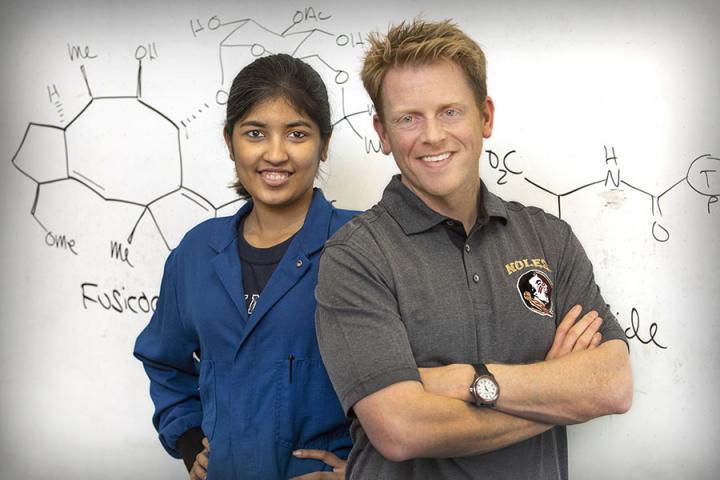
Credit: Bruce Palmer/FSU Photography Services
TALLAHASSEE, Fla. — A fungus that attacks almond and peach trees may be key to identifying new drug targets for cancer therapy.
A team of Florida State University researchers from the Department of Chemistry and Biochemistry found that a natural product from the fungus Fusicoccum amygdali stabilizes a family of proteins in the cell that mediate important signaling pathways involved in the pathology of cancer and neurological diseases.
Their work is published in the journal ACS Chemical Biology.
Assistant Professor James Frederich and Professor Brian Miller found that fusicoccin — a product derived from the fungus — binds to and stabilizes protein complexes formed between 14-3-3 adaptor proteins and a subset of their client interaction partners. The 14-3-3 proteins are essentially major intersections in cells for signaling and regulatory operations. When their functions go awry, a disease is often present.
“Our goal in this study was to take one of the most intractable signaling networks in cell biology and develop a way to study it,” Frederich said. “Our work draws inspiration from a structurally complex natural product, which we used as a tool to identify new targets for cancer cell biology.”
Through this process, Frederich, Miller and their students identified 119 protein-protein interactions (PPIs) that can serve as targets for fusicoccin in humans. Several of these PPIs are important in cancer and other diseases. The research team has already narrowed that list down to 14 PPI targets that they find particularly promising.
“Our discovery of several new putative biological targets, which could clarify the mechanism of action of this natural product, is a major step forward,” Miller said. “Identifying these new targets is very exciting, as is the potential to inform the design of fusicoccin derivatives with tailored activities.”
The work is an ongoing collaboration between Frederich and Miller, who merged their areas of expertise in organic chemistry and biochemistry to explore the potential of fusicoccin.
“The unique combination of experiments and bioinformatics presented in this work lies squarely at the interface between chemistry and biology,” Miller said. “We are hopeful that these types of chemical biology collaborations can be expanded.”
###
This work is funded by the National Institutes of Health and supported by the Pfeiffer Endowed Professorship for Cancer Research. FSU graduate students Ananya Sengupta and Josue Liriano also contributed to this research.
Media Contact
Kathleen Haughney
[email protected]
850-644-1489
Original Source
https:/



